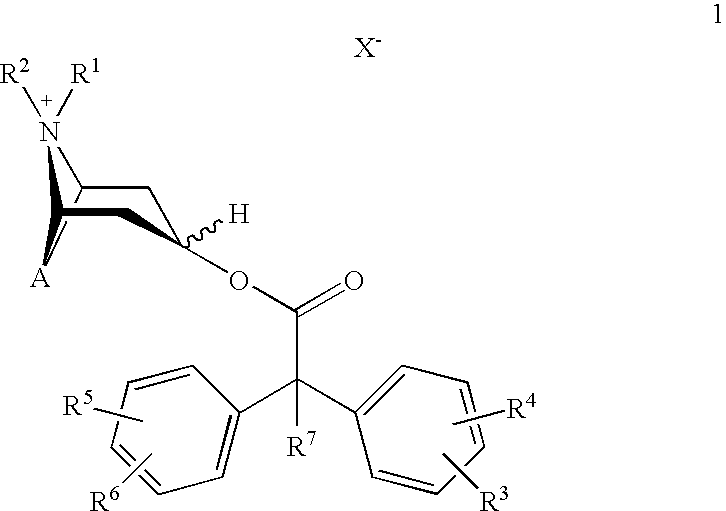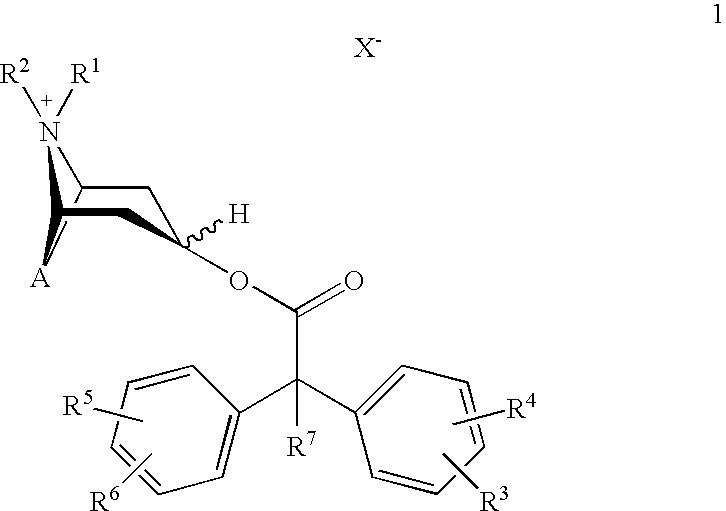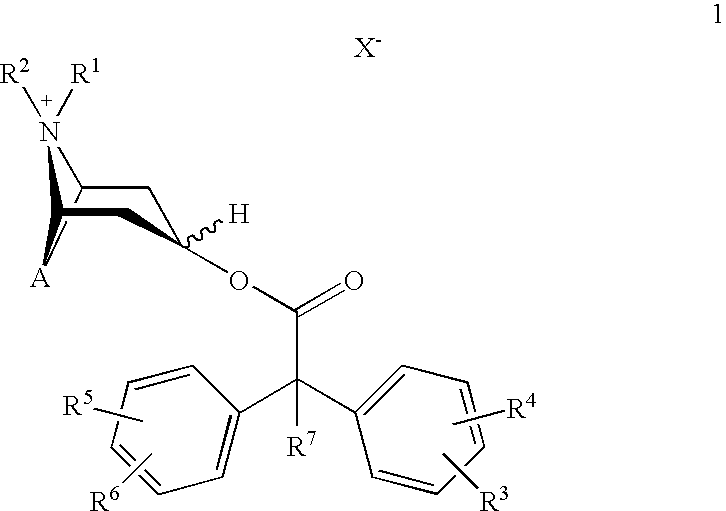Anticholinergics which may be used as medicaments as well as processes for preparing them
a technology of anticholinergics and processes, applied in the field of new anticholinergics, can solve the problems of not meeting the stringent requirements of benzilic acid esters of scopine, tropenol, and tropine, and cannot be used therapeutically for administration in a single dose per day
- Summary
- Abstract
- Description
- Claims
- Application Information
AI Technical Summary
Benefits of technology
Problems solved by technology
Method used
Image
Examples
example 1
scopine 2,2-diphenylpropionate methobromide
[0108]
1.1.: 2,2-diphenylpropionic acid chloride 3a
[0109]52.08 g (0.33 mol) of oxalyl chloride are slowly added dropwise to a suspension of 25.0 g (0.11 mol) of 2,2-diphenylpropionic acid, 100 mL of dichloromethane, and 4 drops of dimethylformamide at 20° C. The mixture is stirred for 1 hour at 20° C. and 0.5 hours at 50° C. The solvent is distilled off and the residue remaining is used in the next step without any further purification.
1.2.: scopine 2,2-diphenylpropionate 4a
[0110]The residue obtained in step 1.1. is dissolved in 100 mL dichloromethane and at 40° C. a solution of 51.45 g (0.33 mol) of scopine in 200 mL dichloromethane is added dropwise. The resulting suspension is stirred for 24 hours at 40° C., then the precipitate formed is suction filtered and the filtrate is acidically extracted first with water, then with aqueous hydrochloric acid. The combined aqueous phases are made alkaline with aqueous sodium carbonate solution, extr...
example 2
scopine 2-fluoro-2,2-diphenylacetate methobromide
[0112]
2.1: Scopine benzilate 5a
[0113]The preparation of scopine benzilate is known in the art. It is described in WO 92 / 16528.
2.2: scopine 2-fluoro-2,2-diphenylacetate 4b
[0114]2.66 g (0.02 mol) of dimethylaminosulfur trifluoride are cooled to 0° C. in 10 mL of dichloromethane and a solution of 5.48 g (0.015 mol) of scopine benzilate 5a in 100 mL of dichloromethane is added dropwise. Then the mixture is stirred for a further 30 minutes at 0° C. and 30 minutes at 20° C. While cooling, the solution is combined with water, NaHCO3 is added (to pH 7-8), and the organic phase is separated off. The aqueous phase is extracted with dichloromethane, the combined organic phases are washed with water, dried over Na2SO4, and evaporated to dryness. The hydrochloride is precipitated from the residue and recrystallized from acetonitrile. Yield: 6.90 g (85% of theory); melting point: 227° C.-230° C.
2.3: scopine 2-fluoro-2,2-diphenylacetate methobromide...
example 3
tropenol 2,2-diphenylpropionate methobromide
[0116]
3.1.: methyl 2,2-diphenylpropionate 3b
[0117]37.60 g (0.247 mol) of DBU are added dropwise to a suspension of 50.8 g (0.225 mol) of 2,2-diphenylpropionic acid and 200 mL of acetonitrile at 20° C. 70.10 g (0.494 mol) of methyl iodide are added dropwise to the resulting solution within 30 minutes. Then the mixture is stirred overnight at 20° C. The solvent is evaporated down, the residue is extracted with diethylether / water, the organic phase is washed with water, dried over Na2SO4, and evaporated to dryness. Yield: 48.29 g of viscous residue 3.1. (89% of theory).
3.2: tropenol 2,2-diphenylpropionate 4c
[0118]4.80 g (0.02 mol) of methyl 2,2-diphenylpropionate 3b, 2.78 g (0.02 mol) of tropenol, and 0.046 g of sodium are heated as a melt at 75 mbar for 4 hours over a bath of boiling water, shaking from time to time. After cooling, the sodium residues are dissolved with acetonitrile, the solution is evaporated to dryness, and the residue ext...
PUM
| Property | Measurement | Unit |
|---|---|---|
| temperature | aaaaa | aaaaa |
| temperature | aaaaa | aaaaa |
| temperature | aaaaa | aaaaa |
Abstract
Description
Claims
Application Information
 Login to View More
Login to View More - R&D
- Intellectual Property
- Life Sciences
- Materials
- Tech Scout
- Unparalleled Data Quality
- Higher Quality Content
- 60% Fewer Hallucinations
Browse by: Latest US Patents, China's latest patents, Technical Efficacy Thesaurus, Application Domain, Technology Topic, Popular Technical Reports.
© 2025 PatSnap. All rights reserved.Legal|Privacy policy|Modern Slavery Act Transparency Statement|Sitemap|About US| Contact US: help@patsnap.com



